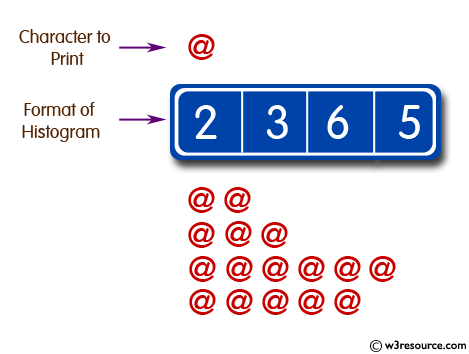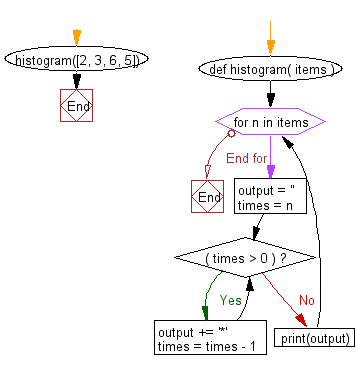Python: Histogram
List Histogram
Write a Python program to create a histogram from a given list of integers.
Pictorial Presentation:

Sample Solution:
Python Code:
# Define a function called histogram that takes a list of items as a parameter.
def histogram(items):
# Iterate through the items in the list.
for n in items:
output = '' # Initialize an empty string called output.
times = n # Set the times variable to the value of n.
# Use a while loop to append '*' to the output string 'times' number of times.
while times > 0:
output += '*'
times = times - 1 # Decrement the times variable.
# Print the resulting output string.
print(output)
# Call the histogram function with a list of numbers and print the histogram.
histogram([2, 3, 6, 5])
Sample Output:
** *** ****** *****
Explanation:
The function "histogram" takes a parameter "items ", a list of integers. To iterate through each item in the "items" list, the function uses a for loop. For each iteration, it creates a varaible "output", and assigns the current element (n) of the loop to the variable "times".
Then it uses a while loop which will run as long as the value of "times" is greater than 0. Inside the while loop, it concatenates an asterisk (*) character to the "output" variable and decrements the value of "times" by 1 at each iteration. After the while loop completes, it prints the final value of "output" variable.
The last line of code calls the "histogram" function with a list of integers ([2, 3, 6, 5]) as an argument, it will print a histogram of asterisks, where the number of asterisks corresponds to the value of the integers in the list.
Flowchart:

For more Practice: Solve these Related Problems:
- Write a Python program to generate a histogram from a list but sort the values in ascending order before displaying.
- Write a script that displays a histogram using asterisks (*) but aligns them to the right.
- Write a program that prints a histogram where each bar is represented by the first letter of a given word.
- Write a Python program that normalizes a histogram so that the largest value corresponds to a fixed maximum width.
Go to:
Previous: Write a Python program to check whether a specified value is contained in a group of values.
Next: Write a Python program to concatenate all elements in a list into a string and return it.
Python Code Editor:
What is the difficulty level of this exercise?
Test your Programming skills with w3resource's quiz.
